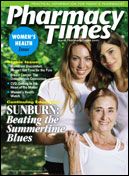Publication
Article
Pharmacy Times
Bacterial Vaginosis: Facts and Myths
This article discusses treatment options for this common condition and ways to decrease the risk of infection.
Drs. Kyle and Butcher are both assistantprofessors of pharmacy practiceat the Gregory School of Pharmacy atPalm Beach Atlantic University,WestPalm Beach, Florida.
Bacterial vaginosis (BV), trichomoniasis,and candidiasis are the3 most frequent infections associatedwith vaginal discharge. Amongsexually active women in the UnitedStates, BV is the most prevalent vaginaldischarge infection.1
BV results from an imbalance betweennormal hydrogen peroxide?producingLactobacillus sp and overgrowth of multiplepathogens in the vagina.1,2 The exactetiology of this imbalance is not fullyknown. Pathogens most commonly isolatedinclude Gardnerella vaginalis,Mycoplasma hominis, Bacteroides sp(other than Bacteroides fragilis), Ureaplasmaurealyticum, Prevotella sp, andMobiluncus sp. Although a majority ofwomen with BV remain asymptomatic,some may experience bothersomesymptoms, such as vaginal discharge,malodor, and rarely vaginal pain, itching,and burning.2
Common Myths
BV is not considered a sexually transmitteddisease (STD), but it appears to berelated to sexual activity because thosewho are not sexually active are rarelyaffected.1 Other risk factors that may leadto disruption of normal vaginal flora andincrease the chances of developing BVinclude multiple or new sex partners, frequentvaginal douching, use of anintrauterine contraceptive device, andlack of vaginal lactobacilli.1 Toilet seats,bedding, and swimming pools are not riskfactors for the development of BV.2
Treatment
BV should be treated in all patientswho are symptomatic and in asymptomaticpregnant patients at risk forpreterm delivery.1 The benefits of treatingBV are relief from vaginal symptoms andsigns of infection, reduction in the risk forinfectious complications following surgicalabortion or hysterectomy, and possiblya reduction in the risk for other infections(eg, HIV and STDs).1
The regimens currently recommendedby the Centers for Disease Control andPrevention (CDC) include either oral orintravaginal preparations of metronidazoleor clindamycin (Table). Both medicationshave shown to achieve cure rates of>90% when taken as recommended.1Treatment of male sexual partners is notrecommended and is usually unnecessary,as the organisms responsible forgenerating BV symptomology do not persistin the male urethra.
As a reminder, alcohol should be avoidedin all patients using metronidazole(both oral and intravaginal) for the durationof treatment and for 24 hours afterthe last dose. The combination of metronidazoleand alcohol in any form may leadto a disulfiram-like reaction with symptomsof flushing, nausea, vomiting, thirst,palpitations, chest pain, vertigo, andhypotension.
Clindamycin cream is an oil-basedpreparation, so patients should be counseledthat it could weaken latex condomsand diaphragms for up to 5 days afteruse. Clindamycin also should be avoidedduring the second half of pregnancy dueto risk for low birth weight infants andneonatal infections. Metronidazole useduring pregnancy has not been associatedwith teratogenic or mutagenic effectsin newborns.
Although not reflected in the currentCDC recommendations, tinidazole, anoral antiprotozoal drug available since2004, recently has been approved fortreatment of bacterial vaginosis.3 Tinidazole'sspectrum of activity against BV,adverse side-effect profile, and druginteractions seem to be similar to that ofmetronidazole.3,4 The recommendeddose of tinidazole for BV is 2 g once dailyfor 2 days or 1 g once daily for 5 days, andit is available in 250- and 500-mg tablets.Currently, studies are underway directlycomparing the efficacy of tinidazole andmetronidazole in treating BV to assist cliniciansin establishing tinidazole's role.
Alternatives to antibiotics also are beinginvestigated. Preliminary evidenceshows Lactobacillus acidophilus intravaginalsuppositories to be of benefit inthe treatment of BV, as well as the oralconsumption of Lactobacillus-enrichedyogurt. Yogurt intravaginal suppositoriesshould not be recommended as theLactobacillus found in yogurt is not thesame as that found in normal vaginalflora. Another treatment under investigationis the use of tea tree oil; however,this should not be recommended untilfurther data are available.
Recurrence of bacterial vaginosissymptoms is fairly common due to continued infection by BV-associated organismsand/or the continued deficiencyof Lactobacillus sp in the vagina.1 Womenshould be advised to follow up with theirphysician and return for additional treatmentif symptoms do not resolve.Recurrent infections can be managedeither with the original regimen or analternative regimen; however, a specialistshould be consulted for women withmultiple recurrences.2
Patient Education
Patient counseling and educationregarding BV should include an explanationof the disease, treatment options,and risk reduction. Inform patientsto report malodorous, especiallyfishy smelling, vaginal discharge. Remindpatients that although BV is notsexually transmitted, an increased riskof infection exists in patients with newor multiple sexual partners. To decreasethe risk of developing BV, remindpatients to avoid douching andlimit the number of sexual partners.
Table
Treatment Regimens for Bacterial Vaginosis
Recommended
Metronidazole tablets
500 mg orally bid for 7 days
Metronidazole gel 0.75%
One full applicator (5 g) intravaginally qd for 5 days
Clindamycin cream 2%
One full applicator (5 g) intravaginally at bedtime for 7 days
Alternative
Clindamycin capsules
300 mg orally bid for 7 days
Clindamycin ovules
100 mg intravaginally at bedtime for 3 days
Recommended for Pregnant Women
Metronidazole tablets
500 mg orally bid for 7 days
Metronidazole tablets
250 mg orally tid for 7 days
Clindamycin capsules
300 mg orally bid for 7 days
Adapted from references 1 and 2.
References
- Centers for Disease Control and Prevention. Sexually transmitted disease treatment guidelines. MMWR. 2006;55:49-52.
- Bacterial vaginosis. Center for Disease Control and Prevention Web site. www.cdc.gov/std/bv/STDFact-Bacterial-Vaginosis.htm. Accessed February 7, 2008.
- Tinidazole (Tindamax)-a new antiprotozoal drug. Med Lett Drugs Ther. 2004;46:70-72.
- Austin MN, Meyn LA, Hillier SL. Susceptibility of vaginal bacteria to metronidazole and tinidazole. Anaerobe. 2006;12:227-230.







